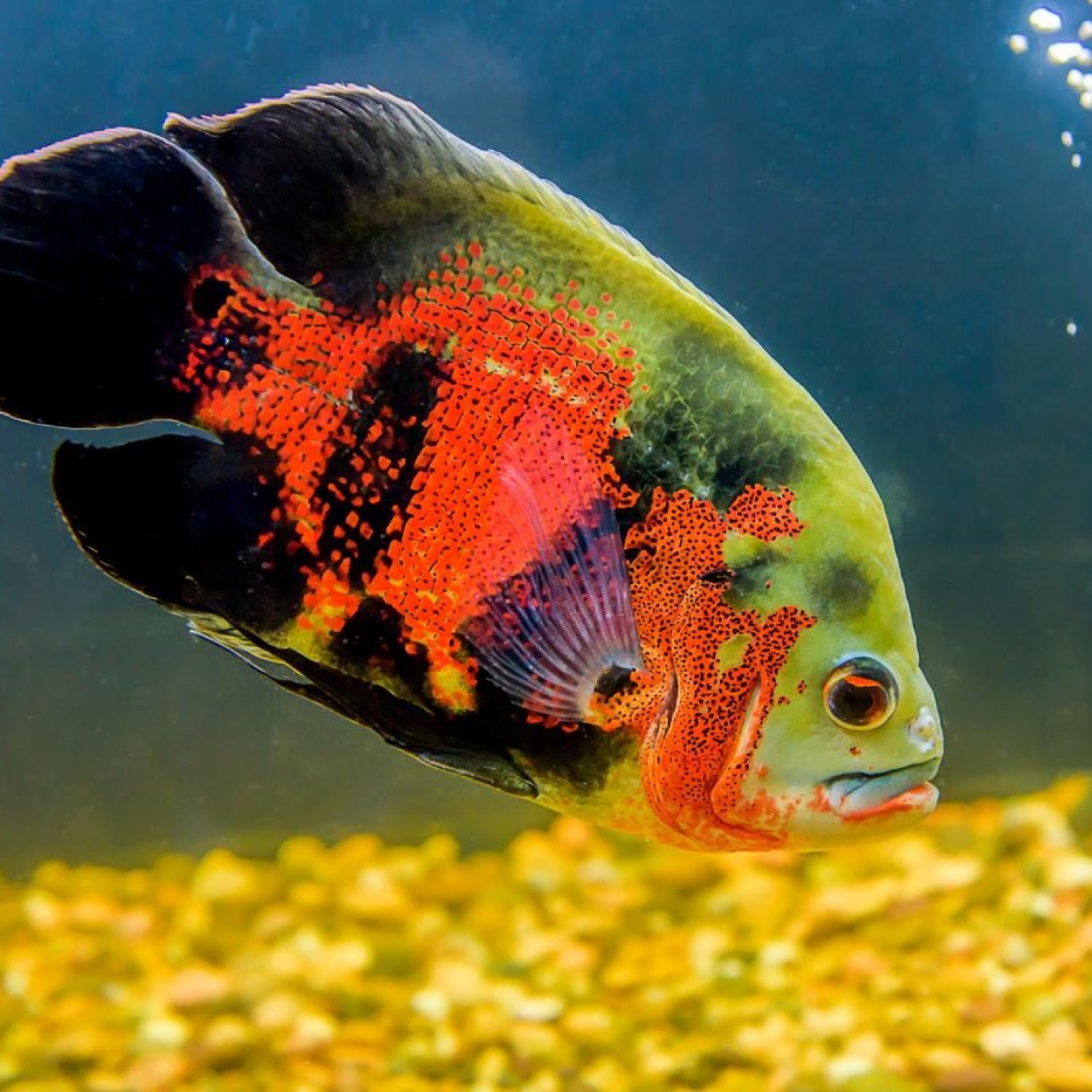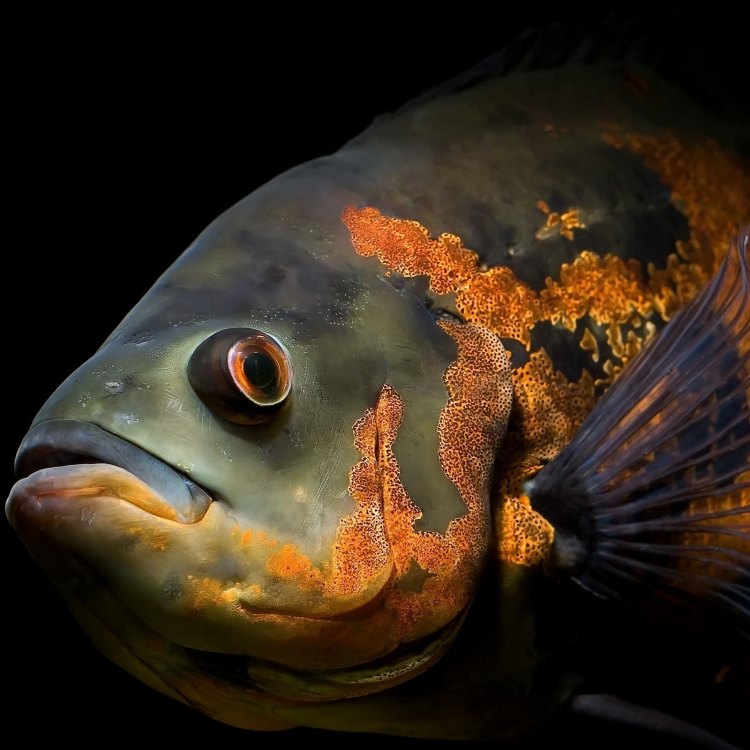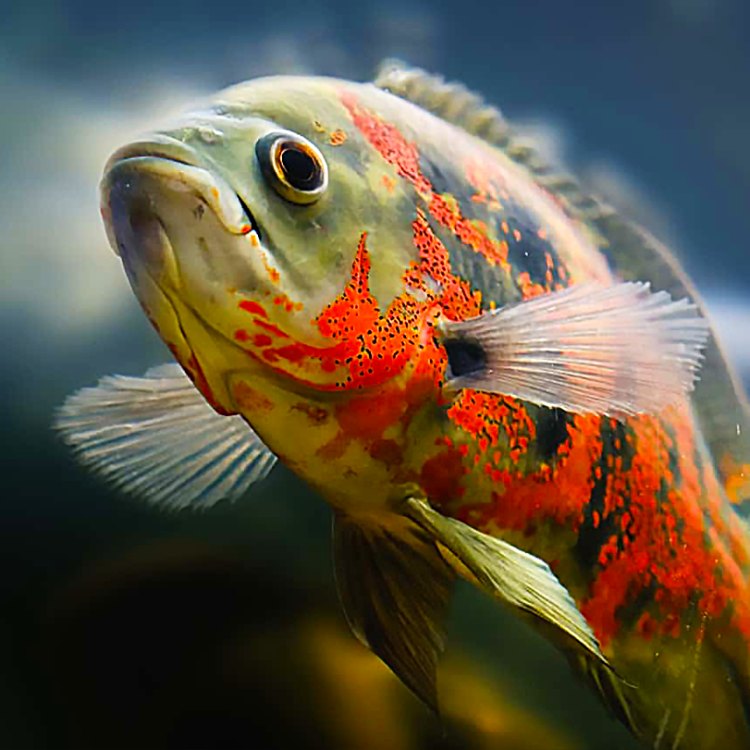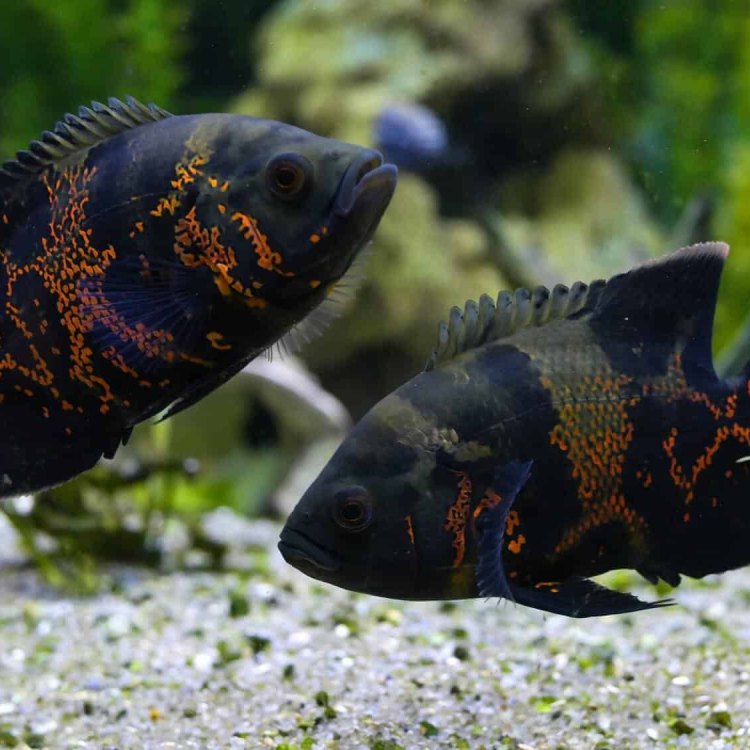
Oscar Fish
Up to 12-15 inches (30-38 cm)
Looking to add a colorful and interesting fish to your home aquarium? Consider the Oscar Fish! With a maximum length of 12-15 inches, this tall and oval-shaped fish is a popular choice for aquariums, ponds, and lakes. Belonging to the Cichlidae family, the Oscar Fish can be found in a variety of vibrant colors and patterns, making them a striking addition to any aquatic display.
Animal Details Summary:
Common Name: Oscar Fish
Kingdom: Animalia
Habitat: Freshwater
The Fascinating World of Oscar Fish
Have you ever seen a fish that can stand out in a sea of other fish? A fish with an interesting personality, striking colors, and unique shape? If you have, chances are you were looking at an Oscar Fish (Astronotus ocellatus). These beautiful creatures are a popular choice among fish enthusiasts and are often the star attraction of any aquarium. Let's dive into the fascinating world of Oscar Fish and discover what makes them so special.Scientific Classification
First things first, let's get familiar with the scientific classification of Oscar Fish Oscar Fish. They belong to the Animalia kingdom, which is the largest group in the animal kingdom. Within that kingdom, they fall under the Phylum Chordata, which includes animals with a backbone. They then belong to the Class Actinopterygii, which includes all ray-finned fishes. Finally, Oscar Fish are a part of the Order Perciformes, and the Family Cichlidae. These are some of the largest families of freshwater fishes.Habitat and Distribution
Oscar Fish are freshwater fish that are native to the Amazon River basin in South America. They can be found in several countries in South America, including Brazil, Colombia, Ecuador, and Peru. They live in rivers, lakes, and ponds, but they can also be found in aquariums all over the world. In the wild, Oscar Fish prefer slow-moving rivers and streams with plenty of hiding places, such as vegetation and rocks Otter.Physical Characteristics
One of the most striking features of Oscar Fish is their coloration. They come in a variety of colors, including black, orange, red, yellow, and even albino varieties. Their colors can be solid or patterned, with some having spots or stripes. These colors are not only beautiful, but they also help the fish blend into their surroundings in the wild.In terms of their body shape, Oscar Fish have an elongated, oval-shaped body with a continuous dorsal fin and a rounded tail fin. They have a prominent forehead and a large mouth, which they use to capture their prey. They also have a unique sensory organ called the lateral line, which runs along the length of their body and helps them detect movement and vibrations in the water.
Size and Lifespan
Oscar Fish can grow up to 12-15 inches (30-38 cm) in length, making them one of the largest freshwater aquarium fish. In the wild, they can grow even bigger, reaching up to 18 inches (45 cm). They have a lifespan of 10-15 years, but with proper care, they can live up to 20 years in captivity.Feeding and Behavior
Oscar Fish are known to be carnivorous, which means they feed on other animals. In the wild, their diet consists of smaller fish, insects, worms, and crustaceans. In captivity, they can be fed a variety of foods, including commercial pellets, live or frozen foods, and even vegetables. It is important to provide them with a balanced diet to ensure their overall well-being and health.Aside from their unique coloration, one of the reasons why Oscar Fish are so popular is because of their interesting behavior. They are intelligent and can be trained to perform simple tricks, such as eating from their owner's hand. They are also known to have a curious and playful nature, which makes them enjoyable to watch.
Caring for Oscar Fish
To provide the best care for Oscar Fish, it is important to replicate their natural habitat as closely as possible. This means providing them with a large tank (at least 50 gallons) with plenty of hiding places and decorations. The water should be kept at a temperature of 75-80°F (24-27°C) and the pH level should be between 6.5-7.5. Regular water changes are also essential to maintain good water quality.One of the challenges of keeping Oscar Fish is their aggression towards other fish. They are territorial and can be aggressive towards smaller or weaker fish. It is important to choose tank mates carefully and provide enough space for each fish to establish its own territory.
Breeding
When it comes to breeding, Oscar Fish are quite easy to breed in captivity. They are monogamous and form pairs during breeding season. The female lays the eggs on a flat surface, and the male fertilizes them. The eggs hatch within a few days, and the fry can be fed baby brine shrimp or crushed flakes.Conclusion
In conclusion, Oscar Fish are truly fascinating creatures. They have unique colors, interesting behavior, and are relatively easy to care for. But most importantly, they bring joy and beauty to any aquarium they are a part of. Whether you are a seasoned fish enthusiast or a beginner, Oscar Fish are a wonderful addition to any fish tank. So next time you see one, take a moment to appreciate their beauty and personality.

Oscar Fish
Animal Details Oscar Fish - Scientific Name: Astronotus ocellatus
- Category: Animals O
- Scientific Name: Astronotus ocellatus
- Common Name: Oscar Fish
- Kingdom: Animalia
- Phylum: Chordata
- Class: Actinopterygii
- Order: Perciformes
- Family: Cichlidae
- Habitat: Freshwater
- Feeding Method: Carnivorous
- Geographical Distribution: Amazon River basin in South America
- Country of Origin: Brazil
- Location: Aquariums, ponds, and lakes
- Animal Coloration: Varied colors including black, orange, red, yellow, and albino varieties
- Body Shape: Tall and oval-shaped
- Length: Up to 12-15 inches (30-38 cm)

Oscar Fish
- Adult Size: Around 10-12 inches (25-30 cm)
- Average Lifespan: 10-15 years in captivity
- Reproduction: Egg-laying
- Reproductive Behavior: Oscars are pair-bonded and lay their eggs on a flat surface
- Sound or Call: No specific sound or call
- Migration Pattern: Non-migratory
- Social Groups: Solitary or form pairs
- Behavior: Aggressive towards other fish, especially during breeding
- Threats: Habitat destruction, pollution, and overfishing
- Conservation Status: Not listed
- Impact on Ecosystem: Oscars can have a negative impact on native fish populations when introduced outside their natural range
- Human Use: Popular aquarium fish
- Distinctive Features: Large size, unique coloration patterns, and dorsal fin with sharp spines
- Interesting Facts: Oscar fish have a complex social structure and can recognize their owners
- Predator: Larger predatory fish

Astronotus ocellatus
The Fascinating World of Oscar Fish: Size, Behavior, and Impact on Ecosystem
The underwater world is filled with diverse and fascinating creatures, from the smallest colorful fish to the largest ferocious predators. One such intriguing species that captures the attention of fish enthusiasts and hobbyists alike is the Oscar Fish. Known for their distinctively large size, unique coloration patterns, and sharp spined dorsal fins, these majestic fish have captured the hearts of many.In this article, we will dive into the captivating world of Oscar Fish, exploring their size, behavior, and impact on the ecosystem PeaceOfAnimals.Com. We will also touch upon their reproductive behavior, social structure, and how humans have come to use them for their own purposes.
So, get your diving gear ready, and let's take a deep dive into the mysterious and captivating world of Oscar Fish.
The Basics
The Oscar Fish (Astronotus ocellatus), also known as the Velvet Cichlid, is a freshwater fish native to South America, particularly the Amazon River basin. They can also be found in various other parts of South America, such as Peru, Colombia, and Brazil.These fish are known for their large size, with adult Oscars growing up to 10-12 inches (25-30 cm) in length. They have a lifespan of 10-15 years in captivity, making them long-term companions for fish enthusiasts. However, in the wild, their lifespan can be significantly shorter due to various threats and predators.
Reproductive Behavior
As egg-layers, Oscars have a specific reproductive behavior. They are pair-bonded, meaning that once they find a mate, they will remain together for future breeding cycles Opossum. During the breeding season, Oscars will lay their eggs on a flat surface, such as a large leaf or rock, in their environment.Interestingly, Oscars are known to be attentive parents, with both male and female taking turns guarding the eggs and fry (baby fish). They will also use their fins to fan and oxygenate the eggs, ensuring their survival.
Social Behavior
Oscars are social creatures, but their social structures can vary. Some Oscars may be solitary, while others may form pairs with their mate. In the wild, they are also known to form small groups with other native fish species.However, their social behavior can also take an aggressive turn, especially during breeding. Male Oscars can become territorial and aggressive towards other fish, including their own species. They may also exhibit aggressive behavior when they feel threatened or during feeding time.
The Oscar's Impact on the Ecosystem
While Oscars are not listed as a threatened or endangered species, they can have a significant impact on their ecosystem when introduced outside of their natural range. This is because they are large, aggressive predators that can outcompete and prey on native fish species.Furthermore, the introduction of Oscars in non-native habitats is often unintentional. Many people may release their pet Oscars into nearby water bodies, thinking they are doing the fish a favor by setting them free. However, this can have disastrous consequences on the local ecosystem.
Human Use
One of the main human uses of Oscar Fish is as a popular aquarium fish. Their unique coloration patterns, large size, and interesting behavior make them a sought-after fish for aquarium enthusiasts. They are relatively easy to care for, making them a popular choice for novice fish hobbyists as well.Aside from being kept as pets, Oscars are also used for human consumption in certain parts of the world, particularly in South America. Their flesh is said to have a mild flavor and is often used in various local dishes.
Distinctive Features
Oscar Fish are easily recognizable due to their large size and unique features. Their coloration can vary, but they typically have a combination of dark and light hues, giving them a marbled or spotted appearance. They also have a sharp spined dorsal fin, which they use for defense and aggression towards other fish.Another interesting feature of Oscar Fish is that they have the ability to change color slightly and even take on a metallic sheen when breeding or under stress. This is believed to be a way for them to communicate with other fish in their environment or to attract potential mates.
Interesting Facts
Aside from their distinctive physical features, Oscar Fish also have some interesting facts that make them stand out from other fish species. One such fact is that they have a complex social structure, with the ability to recognize their owners. This is primarily due to their intelligence and ability to form strong bonds with their caretakers.Furthermore, Oscars have been observed exhibiting similar behaviors to dogs, such as wagging their tails and begging for food from their owners. This has made them a favorite among fish lovers who enjoy interacting with their aquatic pets.
Predators of Oscar Fish
Despite their large size and aggressive behavior towards other fish, Oscar Fish can still become prey to larger predatory fish in their natural habitat. Fish such as Arowanas, Peacock Bass, and Piranhas are known to hunt and eat Oscars.In captivity, the risk of predators is significantly reduced, but it is still crucial to provide a safe and secure environment for these fish to thrive.
In Conclusion
In conclusion, Oscar Fish may seem like just another decorative aquarium fish, but they have much more to offer. Their complex social structure, interesting reproductive behavior, and ability to recognize their owners make them unique and fascinating creatures.However, it is also essential to remember their impact on the ecosystem and to be responsible pet owners when choosing to keep them. With proper care and attention, Oscars can live up to 15 years, making them long-term companions that will continue to fascinate and captivate us with their beauty and behavior. So, the next time you come across an Oscar Fish, take a moment to appreciate all the fascinating characteristics that this species has to offer.

The Fascinating World of Oscar Fish
Disclaimer: The content provided is for informational purposes only. We cannot guarantee the accuracy of the information on this page 100%. All information provided here may change without prior notice.












